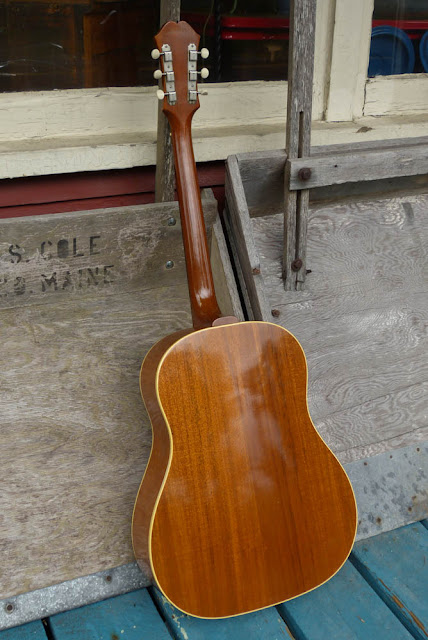1967 Gibson-made Epiphone FT-79N Texan Slope Dread Guitar
It really doesn't get much better than this condition-wise for a 60s slope-dread Gibson. The Epiphone Texans are a bit rarer than their Gibson counterparts (the venerable J-50) and are upscaled more in-line with something like a Southern Jumbo as they feature gorgeous pearl markers in the neck and pearl-inlaid headstock details. This one has the "N" designation for "natural" finish. It's clean-as-heck save for a (repaired) tiny hairline crack next to the pickguard and after work plays beautifully. I don't want to load the hyperbole on but this is right up my alley in terms of functionality and broad-spectrum tone in a dread-shaped guitar.
Just like a J-50 the top is solid spruce, the back and sides are solid mahogany, and the neck is mahogany with a Brazilian rosewood board and bridge. This one has the "ADJ" adjustable bridge but (intelligently) the adjustable-height saddle is a big hunk of rosewood which gives it a nice, rounded tone. Regular readers will know my bias towards the adjustable bridges: they're just very practical and sound good when setup properly. Why would you want to put a "standard" bridge on when you can simply adjust your action every season a notch or two instead of having to pull the saddle, shim it up, or swap it out every season as the guitar shifts?
There's the usual finish weather-check here and there but this example is very clean for its age. It's also entirely original (!) down to the bridge pins.
My work included resetting the fretboard extension (these weren't glued down in the 60s as finish was sprayed under them), regluing the bridge (sans the normal "bolts" that're installed in it), and cleating/fill of a minor hairline crack to the soundhole-side of the pickguard on the top. I then leveled/dressed the frets, cleaned it up, and gave it a good setup with regular 54w-12 lights. It plays perfectly and very comfortably.
As a "chording" machine this is a lovely guitar as the 1 5/8" nut width plus hybrid C/D fast-feeling neck let barred chords ring out easily up and down the neck. It flatpicks just fine, too, with that typical Gibson accented midrange and dry, thunking bottom-end which records wonderfully.
"Real pearl" in the headstock recalls much earlier Gibson-made products...
...and the Epi-style pearl markers look great, don't they?
The original medium frets are almost full-height after a light level/dress.
Can't argue with that pickguard shape, either...
When this came in, the bridge was split to the bass side along the pinholes and bolt-hole covered by that pearl-dot. The factory (idiotically) relied on the bolts to hold the bridge on, as it really wasn't glued down to the top at all except for a tiny few dots of glue here and there. I actually had to scribe all the way around the bridge outline and peel back all the finish that was under it to give this a good, "natural" bridge-gluing area.
Now the whole foot is glued, of course, and the bolts are no-longer needed, so I've left them out of the equation. Before I reglued the bridge I also (of course) glued the hairline crack up and you can't even tell where it is -- it went back together perfectly and I have no qualms about it holding-up.
Even in this "top-swelled" humid season, the saddle is jacked up and tall over the body despite super-slinky string action. This is dialed-in like it's a brand-new fancy guitar.
The binding is identical to a J-50's...
The mahogany is a nice, natural "golden ginger-ale" color.
The guitar comes with its original chip/semi-hard case with plush lining (for a chip case, that is). It's in decent shape and will serve to protect the guitar for light travel.

























Comments
Cheers
Pete